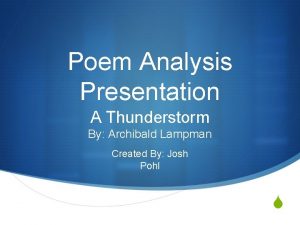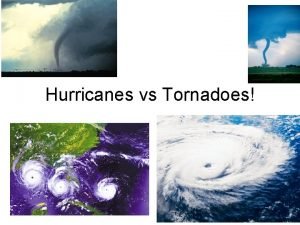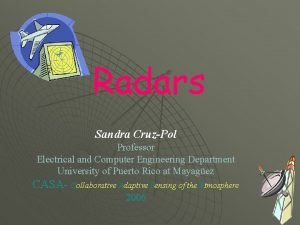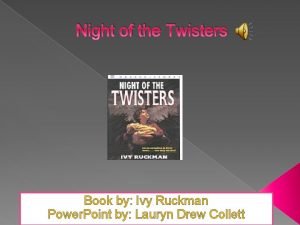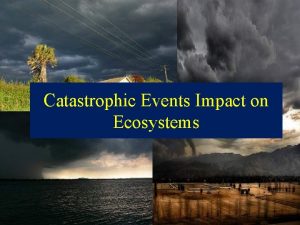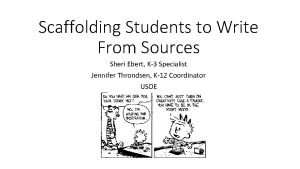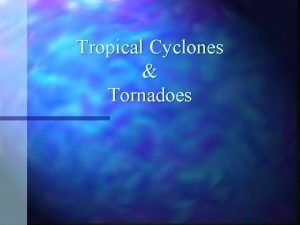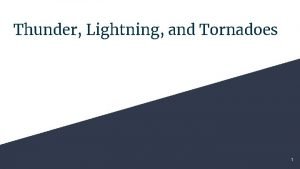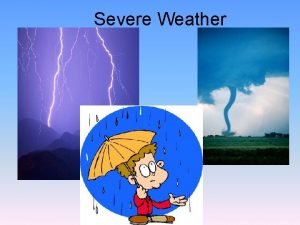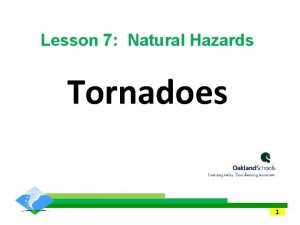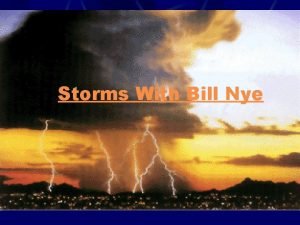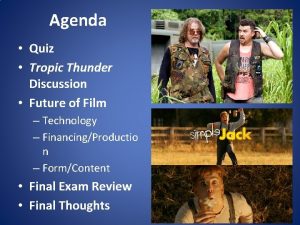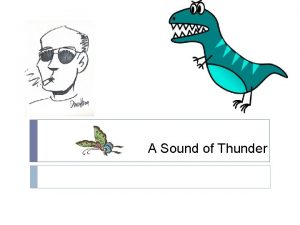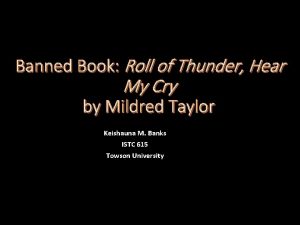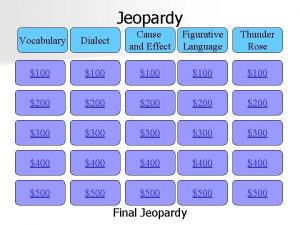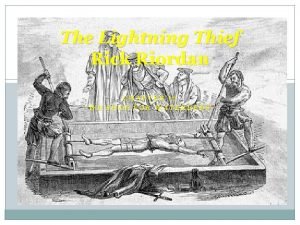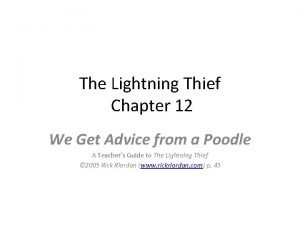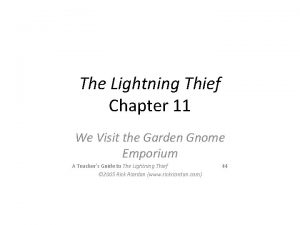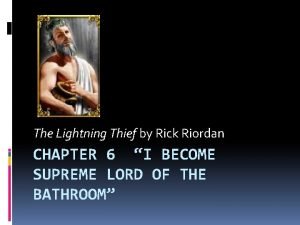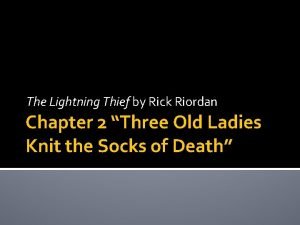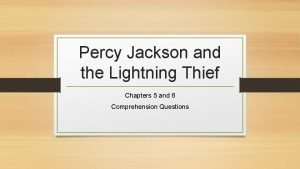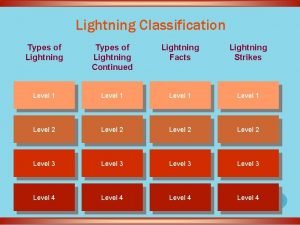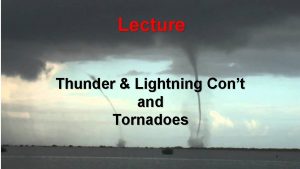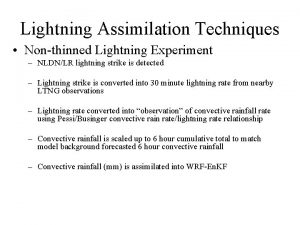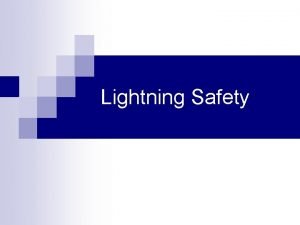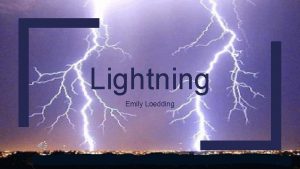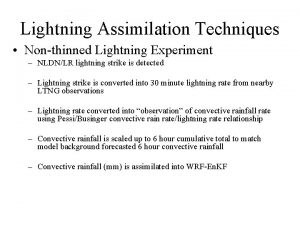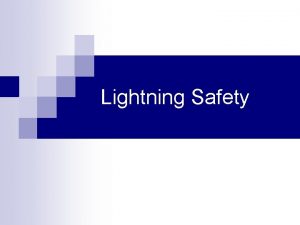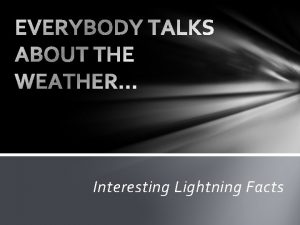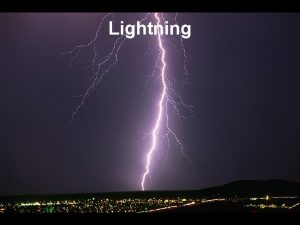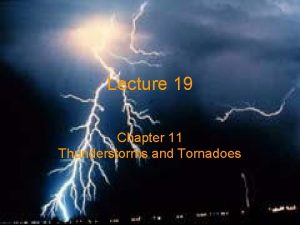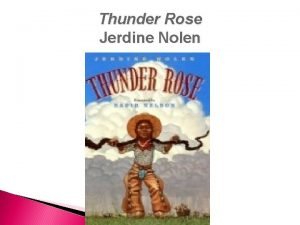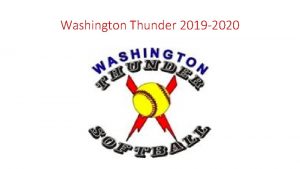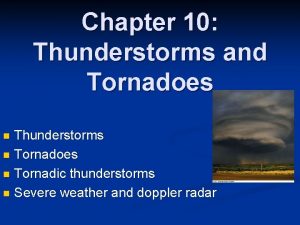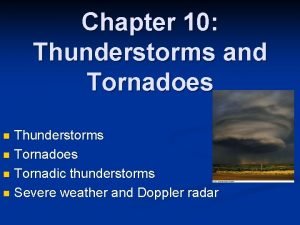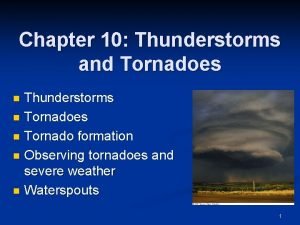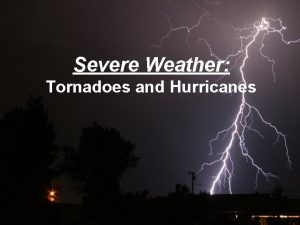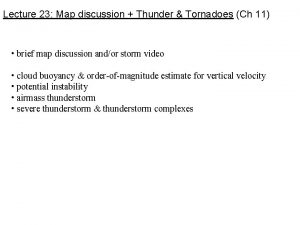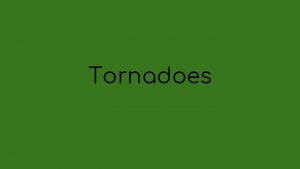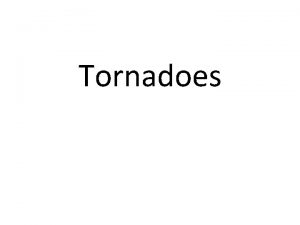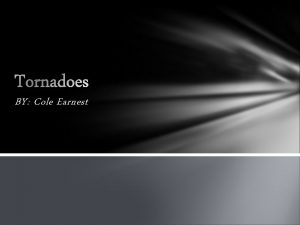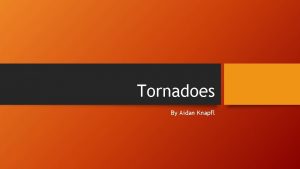Thunder Lightning and Tornadoes 1 What is a




























- Slides: 28

Thunder, Lightning, and Tornadoes 1

What is a thunderstorm? A heavy storm accompanied by rain, thunder _____, lightning, and strong winds. hail and The storm may have ____ tornadoes. Created by surface heating, convection of the warm, moist air rising. atmosphere A way for the _______ to release energy. 2

The three stages of a thunderstorm. 1. Developing/Cumulus a. Warm, moist air rises, water vapor ____ to form cumulus clouds. condenses b. Little to no rain, Lightning present 2. Mature – a. Updraft feeds the storm. ________clouds form. Cumulonimbus b. Heavy rain falls along with air (downdraft) forming a line of gusty winds c. Most likely time for hail, heavy rain, frequent lightning, strong winds, and ______. tornadoes 3. Dissipating – a. Downdraft weakens the updraft, which cuts off the supply of _______. water b. Rainfall decreases, and the cloud begins to evaporate. 3

Stages 4

Stages 5

Severe Storms Severe storms are those with one or more of the following: Hail ● ______ one inch or greater Winds gusting over 57. 5 mph ● ______ Tornado ● A _______ Severe Storm in Sky Harbor, AZ 16 million thunderstorms occur each year worldwide. 100, 000 in the US alone. 10% reach severe levels. 2, 000 thunderstorms at any given time. 6

Season for Storms? spring Most common in ____ and summer months, in the afternoon and evening. WATCH vs WARNING: Watch ● _______ = watch and prepare for severe weather ● ____ = serious threat to Warning life and property. ACT now and find safe shelter 7

Watch versus Warning 8

Types of Thunderstorms Type Description Results Single-cell storm Small, brief, weak. Grow and die within an hour. Brief heavy rain and lightning. Multi-cell storm Typical. Individual cells last 30 -60 mins, while the system lasts many hours. May produce hail, strong winds, brief tornadoes and/or flooding. Squall line Group of storms in a line, tending to pass quickly. Can be hundreds of miles long, but only 10 -20 miles wide. High winds and heavy rains. Less prone to tornadoes than supercells. Supercell Long-lived (more than 1 hr) well organized storm feeding off an updraft. 10 miles in diameter, up to 50, 000 ft tall Forms 20 -60 before a tornado (small extension of larger rotation). Largest, violent tornadoes come from supercells. 9

Squall line 10

Supercell 11

Lightning… what is it? electricity A giant spark of _____ in the atmosphere. ○ ○ ○ From cloud to cloud. From cloud to ground. From ground to cloud. positive and _______ negative charges in atmosphere Due to the build-up of ______ (occurring within a thunderstorm cloud or cloud and ground). Thunder - Energy from a lighting channel heats the air to Causes _______ 18, 000℉ , causing the air to rapidly expand… BOOM (thunder). 12

Lightning 13

What causes Lightning - The Debate Precipitation Theorists Varying sized rain, hail, and graupel get their positive or negative charge as they collide. Heavier particles carry negative charges to the lower region of a cloud. Convection Theorists Updrafts transport positive charges found near the ground upward, while downdrafts carry negative charges downward. * 14

How far away is the lightning? 15

Tornadoes ● ● A tornado is a small, shortfunnel lived, _______-shaped storm that extends below the base of a cumulonimbus cloud. The base of the funnel may be 6 feet to 2 miles wide. rotates The tornado _______ rapidly. 250 mph. Winds may be up to ___ 16

Tornadoes ● ● ● Tornadoes are white if there is water condensation when they first form ______. Tornadoes become dark when debris they suck up ____. Most tornadoes travel less than 6 miles. ___ 17

Tornadoes ● ● ● 1, 000 There about ____ tornadoes in the United States every year. 75% of the world’s tornadoes ____ occur in the Great Plains of the US. Tornado Alley This is called _____. 18

Tornadoes ● Tornado Alley may be shifting east to the ______. 19

Tornadoes- Tornado Alley may be moving east 20

Tornadoes ● Tornadoes over water are waterspouts called ______. ● The waterspout can suck up fish and frogs and then they rain down up to 100 miles away. 21

Tornadoes ● ● ● conditions are right for a tornado. A tornado watch means _____ spotted A tornado warning means a tornado has been _____. The average warning time is 13 minutes. 22

Tornadoes ● ● Tornado season is the spring _______. (March-May in Illinois) However, tornadoes may occur any time of year. Plainfield The ______ tornado was August 28, 1990. It struck Plainfield High School at 3: 30 pm. 23

Tornadoes 24

Tornadoes 25

Tornadoes 26

Tornado scale ● ● ● The _______ Scale rates the Fujita intensity of the tornado. It was developed by Tetsuya Fujita at the University of Chicago. In 2007 it was replaced with the Enhanced Fujita Scale (EFS). 27

Enhanced Fujita Scale 28
 Macbeth thunder and lightning
Macbeth thunder and lightning A thunderstorm poem summary
A thunderstorm poem summary What causes thunder and lightning
What causes thunder and lightning Contrast signal words
Contrast signal words Compare and contrast signal words
Compare and contrast signal words Hurricane versus tornado
Hurricane versus tornado Sandra cruz denton tx
Sandra cruz denton tx Night of the tornadoes book
Night of the tornadoes book Tornado impact to ecosystem
Tornado impact to ecosystem How do tornadoes affect humans
How do tornadoes affect humans Tropical cyclone tornadoes
Tropical cyclone tornadoes What is tornado
What is tornado The thunder was accompanied ____ heavy rains
The thunder was accompanied ____ heavy rains Three ingredients for a thunderstorm
Three ingredients for a thunderstorm Effects of tornadoes
Effects of tornadoes Bill nye severe weather
Bill nye severe weather Tropic thunder budget and gross
Tropic thunder budget and gross What causes the sound of thunder
What causes the sound of thunder Thunder bay district humane society
Thunder bay district humane society Roll of thunder, hear my cry controversy
Roll of thunder, hear my cry controversy Ntranslate
Ntranslate How does annabeth pay for the trip to los angeles?
How does annabeth pay for the trip to los angeles? Percy's dream in chapter 12
Percy's dream in chapter 12 Lightning thief chapter 11
Lightning thief chapter 11 The lightning thief chapter 6 pdf
The lightning thief chapter 6 pdf Chapter 2 the lightning thief
Chapter 2 the lightning thief The trees danced in the wind.
The trees danced in the wind. Percy jackson and the lightning thief dionysus
Percy jackson and the lightning thief dionysus Types of lightning
Types of lightning

